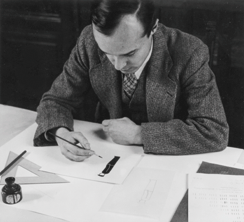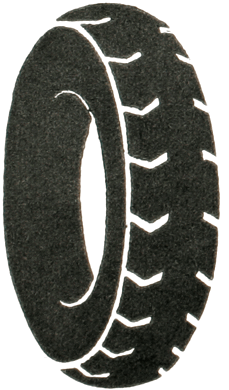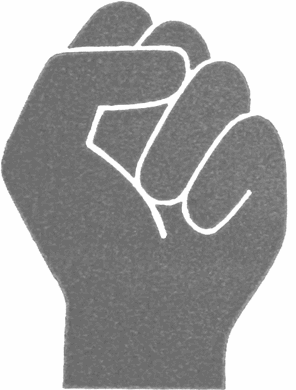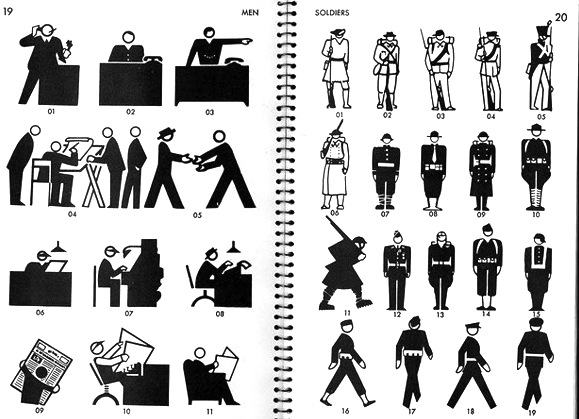|
Gerd Arntz

Between 1928 and 1965, Gerd Arntz (1900-1988) designed around 4000 signs and symbols depicting industry, demographics, politics and economy, for the visual language Isotype. Many of these can be viewed on this web site. Some quotes from that site: - About Arntz himself, the persona: Born in a German family of traders and manufacturers, Gerd Arntz was a socially inspired and politically committed artist. In Düsseldorf, where he lived since his nineteenth, he joined a movement which wanted to turn Germany into a soviet- or council republic, a radically socialist state form based on direct popular democracy. As a revolutionary artist, Arntz was connected to the Cologne based progressive artists group (Gruppe progressiver Künstler Köln) and depicted the life of workers and the class struggle in abstracted figures on woodcuts. Published in leftist magazines, his work was noticed by Otto Neurath, a social scientist and founder of the Museum of Society and Economy (Gesellschafts- und Wirtschaftsmuseum) in Vienna, Austria. Neurath had developed a method to communicate complex information on society, economy and politics in simple images. For his Vienna method of visual statistics, he needed a designer who could make elementary signs, pictograms that could summarize a subject at a glance. Arntz's clear-cut style suited Neurath's goals perfectly, and so he invited the young artists to come to Vienna in 1928, and work on further developing his method, later known as ISOTYPE, International System Of TYpographic Picture Education. During his career, Arntz designed around 4000 different pictograms and abstracted illustrations for this system. At the same time, he was working with Neurath and his collaborators on designing exhibitions and publications for the Vienna museum. In this time, the 1930s, the city was under socialist government and an internationally acclaimed center of social housing and workers' emancipation. Neurath's visual statistics were adamantly meant as being an instrument of this emancipation, and Arntz' own socialist background fitted this context seamlessly. Produced under Arntz's creative guidance, a collection of 100 visual statistics, Gesellschaft und Wirtschaft, was published in 1930. The success of this collection lead among other things to an invitation to come to the young Soviet Union and set up an institute for visual statistics, Isostat, in Moscow. Neurath and Arntz regularly traveled to Moscow in the 1930s, until in 1934 the socialist government of Vienna fell. After the Nazi take over, both emigrated with their families to the Netherlands, where they continued working on Isotype in The Hague. When the second world war broke out, Neurath fled to England. Arntz stayed in The Hague, where he worked for the Dutch Foundation of Statistics. Arntz' artistic legacy is administered by the Municipal Museum of The Hague, and a generous selection of his work from this collection is now available on-line for the first time.
- About his gutsy political activism: In his early twenties, the young German artist Gerd Arntz said goodbye to his bourgeois background and committed himself to the struggle of the underprivileged workers. During an artistic career spanning 50 years, he has continually criticized social inequality, exploitation and war in clear-cut prints - activism with artistic means. In Düsseldorf, Arntz attended an art academy in the early 1920s to become a drawing teacher. There, he frequented revolutionary circles, rebel minds who wanted to turn Weimar Germany into a soviet republic, styled after early communist Russia. He also came into contact with the new movements in the arts at the time, such as expressionism and constructivism. For activist artists like Arntz, the wood-cut was the chosen medium, because of its primitive aspect and its clearblack-and-white contrast. In the 1930s, Arntz switched to linoleum-cuts. With his comrades, the Cologne artists Franz Seiwert and Heinrich Hoerle, he read Marxist and anarchist literature and developed his own style of portraying society as segregated in classes, struggling within the technological milieu of the modern city. His prints were exhibited, sold to sympathetic art lovers, and published in magazines of the activist left in Germany and abroad. When Arntz was asked by Otto Neurath to join his team at he Vienna Museum of Society and Economy, and develop Isotype, he took it as an opportunity to expand the reach of his political beliefs into the realm of actively informing the proletariat, albeit as a graphic designer. At he same time, this steady job provided him the means to continue his own artistic work, completely independent of the art market or political affiliations. His prints criticizing the capitalist system did, for instance, not prevent him from critically looking at the downside of the Soviet Union in other prints. After he emigrated to the Netherlands, in 1934, Arntz published a series of prints warning against the danger of Nazism. His concise and biting depiction of the build-up of the Third Reich, published in a Dutch communist magazine in 1936, was removed from an exhibition in Amsterdam after complaints by the German embassy that it insulted a friendly head of state. Arntz continued cutting his social and political critique into linoleum until he was seventy years old.
- About Isotype: The International System Of TYpographic Picture Education was developed by the Viennese social scientist and philosopher Otto Neurath (1882-1945) as a method for visual statistics. Gerd Arntz was the designer tasked with making Isotype's pictograms and visual signs. Eventually, Arntz designed around 4000 such signs, which symbolized keydata from industry, demographics, politics and economy. Otto Neurath saw that the proletariat, which until then had been virtually illiterate, were emancipating, stimulated by socialism. For their advancement, they needed knowledge of the world around them. This knowledge should not be shrined in opaque scientific language, but directly illustrated in straightforward images and a clear structure, also for people who could not, or hardly, read. Another outspoken goal of this method of visual statistics was to overcome barriers of language and culture, and to be universally understood. The pictograms designed by Arntz were systematically employed, in combination with stylized maps and diagrams. Neurath and Arntz made extensive collections of visual statistics in this manner, and their system became a world-wide emulated example of what we now term: infographics.
Ed Annink and Max Bruinsma edited the book Gerd Arntz Graphic Designer (2010, Rotterdam).
|
EXTERNAL LINKS
Gerd Arntz
MyFonts search
Monotype search
Fontspring search
Google search
INTERNAL LINKS
Dingbats (original) ⦿
Type designers ⦿
Type designers ⦿
German type scene ⦿
Dutch type design ⦿
Circle-themed typefaces ⦿
|









